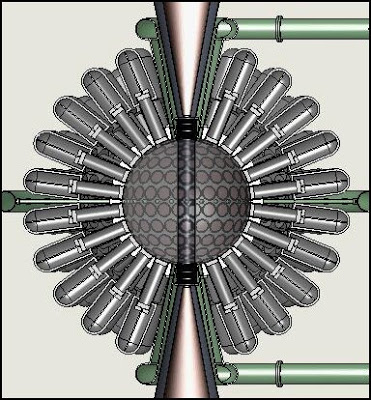Sustainable Development Technology Canada, recently awarded General Fusion a $13.9 million (Canadian) grant toward a four-year project aimed at showing the acoustic pulse system works as claimed. The first phase will focus on making the plasma and building pistons, after which the full-scale system – capable initially of firing its pistons every half-hour – will be constructed.
UPDATE: General Fusion has raised US$9 million in additional funding.
In Dec, 2008 General Fusion had raised $7 million out of a needed $10 million for the second round. However, with the agency funding they probably did not have trouble getting a significant private matching of funds.
The amount of money from SDTC is unprecedented, given the agency’s average deal size is around $3 million. The funds, however, are conditional on the company’s ability to raise another $33 million from private investors. It’s part of the way there. The hope is that enough money can be raised by the end of [April, 2009] to begin the first two-year phase, says Richardson.
Being a Canadian company doesn’t help. “Canada does not have a fusion program, so it’s very challenging. There’s nobody you can talk to, there’s no process in place, nobody who can say yes or no,” says Richardson.
This has required outside consultation. For example, Chrysalix helped get five experts at aerospace titan Boeing Co. to conduct a technical review of General Fusion’s reactor design. The team’s 14-page report was encouraging. “They said they didn’t see any reason why it wouldn’t work, and that the plan is the right plan,” says Brown.
The company has also linked up research efforts with the Los Alamos National Laboratory in New Mexico. It’s one of the few, and most advanced, facilities in the world actively researching Laberge’s brand of fusion.
But Glen Wurden, manager of the fusion energy program at Los Alamos, doesn’t sugar coat the challenges that lie ahead for General Fusion.
“They have a lot of work to do before they are able to show net energy gain,” Wurden wrote in an email dispatch from his lab. He called the idea of pulsing the system every second a unique approach. “But this is the third, or even fourth step in learning how to walk. The first step is still to be demonstrated.”
Brown, who over his 40 years as a venture capitalist has seen many ideas and companies come and go, is the first guy in the room to tell you that delivering a test fusion reactor for $50 million is a tall order that most write off as unlikely, if not impossible.
“We’ve got lots and lots of work to do, and there are lots of uncertainties here,” he says.
“But Laberge – he’s just unbelievable. And between him and Richardson these are very, very smart guys.”
In 10 years, if all goes as planned, the entire world will know exactly how smart.
General Fusion is using the MTF (Magnetized Target Fusion) approach but with a new, patent pending and cost-effective compression system to collapse the plasma. They describe the injectors at the top and bottom of the above image in the new research paper. The goal is to build small fusion reactors that can produce around 100 megawatts of power. The company claims plants would cost around US$50 million, allowing them to generate electricity at about four cents per kilowatt hour.
If there are no funding delays, then in 2010-2011 for completion of the tests and work for an almost full scale version (2 meters instead of 3 meter diameter).
The third phase for General Fusion is to raise $50 million for a net energy gain device with a target date of 2013 if the second/third phase are roughly on schedule. [The canadian government funding and private funding could take General Fusion all the way through the third phase]
If they get $300-500 million for commercialization, the first commercial scale unit could be 2016-2018.
The fifth project funded on this media release page is General Fusion.
5. Lead organization: General Fusion Inc., Burnaby, British Columbia
Project Title: Acoustically Driven Magnetized Target Fusion
Environmental Benefit: Climate Change / Clean Air
Economic Sector: Power Generation
Consortium members:
General Fusion Inc.
Los Alamos National Laboratory
Powertech Labs Inc.Project Description:
To date, attempts at fusion reactions with the objective of producing power have been extremely complex and expensive. General Fusion Inc. is developing fusion technology which uses acoustic waves to create a fusion reaction, thereby generating inexpensive and plentiful electricity without greenhouse gas emissions, pollution, or long lived radioactive waste streams. General Fusion is embarking on the second phase of its technology development which involves the construction of the core components and the assembly of a full scale engine to demonstrate attractive conversion efficiencies. The project will verify the technical and economic viability of General Fusion’s Acoustically Driven Magnetized Target Fusion technology. General Fusion’s engine, when commercialized, has the potential to displace traditional fossil fuel energy sources, greatly reducing greenhouse gas emissions. General Fusion’s demonstration will produce 600MJ of thermal energy per cycle.
Tyler Hamilton wrote the Toronto Star Article and mentions more about General Fusion on his blog.

Brian Wang is a Futurist Thought Leader and a popular Science blogger with 1 million readers per month. His blog Nextbigfuture.com is ranked #1 Science News Blog. It covers many disruptive technology and trends including Space, Robotics, Artificial Intelligence, Medicine, Anti-aging Biotechnology, and Nanotechnology.
Known for identifying cutting edge technologies, he is currently a Co-Founder of a startup and fundraiser for high potential early-stage companies. He is the Head of Research for Allocations for deep technology investments and an Angel Investor at Space Angels.
A frequent speaker at corporations, he has been a TEDx speaker, a Singularity University speaker and guest at numerous interviews for radio and podcasts. He is open to public speaking and advising engagements.


